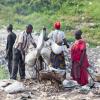
Established by World Climate Research Programme (WCRP), the Task Teams will support the design, scope, and definition of the next phase of CMIP and evolution of CMIP infrastructure and future operationalization.
The World Climate Research Programme (WCRP) Earth System Modelling and Observations (ESMO) project, through its Working Group on Coupled Models’ (WGCM) CMIP panel and WGCM infrastructure panel (WIP), has established a number of Task Teams to contribute to the future direction of CMIP, each composed by a diverse and multidisciplinary team of 8-12 experts in the specific field of the task.
The currently active task teams are:
- Climate Data Citation
- Climate Data Request
- Climate Forcings
- Climate Model Benchmarking
- Climate Model Documentation
- Strategic Ensemble Design
Keywan Riahi, Energy, Climate, and Environment Program Director, will take part to the Climate Forcings Task Team, which mission is to investigate how the CMIP required forcing agents will need to broaden for CMIP7, while Senior Research Scholar Matthew Gidden will be a member of the Strategic Ensemble Design Task, focusing on ensemble design and interpretation to aid scoping of the next phase of the Coupled Model Intercomparison Project (CMIP7).
News

05 June 2024
The 2024 State of CDR Report: Scaling up CO2 removal to meet Paris Targets

23 April 2024
US Permanent Representative to International Organizations in Vienna visits IIASA

15 April 2024

